Refine search
No keyword found to refine search
keywords EN
Places
Names
40 documents found
| 1 |
Documents per page :

Mostly Sudanese, Afghan, Eritrean or Somali, the migrants accommodated in the centre of the Chapel find there an alternative to the wild camps of Stalingrad.
Jan Schmidt-Whitley/Le Pictorium
LePictorium_0177150.jpg
Anis, 29 years old is Sudanese. He is from the town of El-Fasher in Darfur. Before France, it iwent through Libya and Italy. Anis has been in La Chapelle humanitarian centre for 6 days and is waiting to find out where he will be sent after the regulation period of 10 days on average.

Mostly Sudanese, Afghan, Eritrean or Somali, the migrants accommodated in the centre of La Chapelle find there an alternative to the wild camps of Stalingrad.
Jan Schmidt-Whitley/Le Pictorium
LePictorium_0177151.jpg
Rachid Benferhat (left) is the director of the center of La Chapelle. He has been working for Emmaüs for many years. This morning, with his team assigned to the "bubble", he makes sure everything is set before the doors open to the migrants who have been waiting for several hours. Since the number of admissions is limited, not everybody will be granted access to the site.
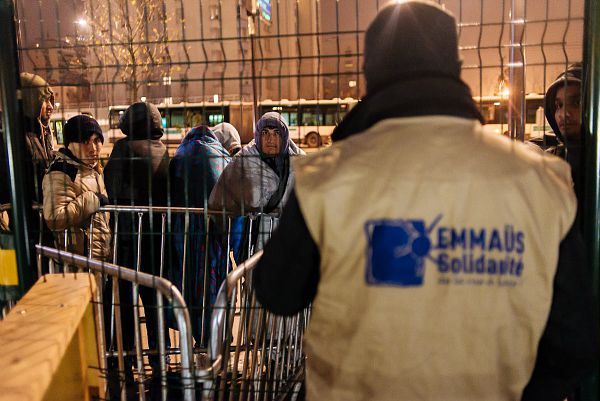
Mostly Sudanese, Afghan, Eritrean or Somali, the migrants accommodated in the centre of La Chapelle find there an alternative to the wild camps of Stalingrad.
Jan Schmidt-Whitley/Le Pictorium
LePictorium_0177152.jpg
In front of the La Chapelle center in Paris run by Emmaüs, many migrants have been queuing for hours to be among the rst 50 who will be able to benefit from accommodation and relocation solutions according to their administrative situation. Usually the doors do not open before 7:30 am / 8 am, every day

Mostly Sudanese, Afghan, Eritrean or Somali, the migrants accommodated in the centre of La Chapelle find there an alternative to the wild camps of Stalingrad.
Jan Schmidt-Whitley/Le Pictorium
LePictorium_0177153.jpg
The first migrants cross the gates of the center of La Chapelle. An employee of Emmaüs gives each and every newcomer a ticket according to their order of arrival to later proceed with the administrative formalities in the relative comfort of the "bubble".
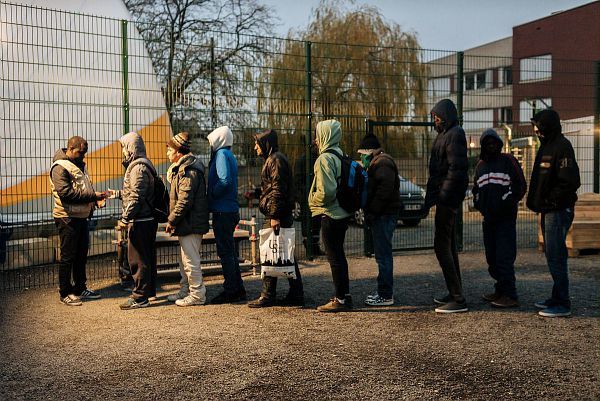
Mostly Sudanese, Afghan, Eritrean or Somali, the migrants accommodated in the centre of La Chapelle find there an alternative to the wild camps of Stalingrad.
Jan Schmidt-Whitley/Le Pictorium
LePictorium_0177154.jpg
In front of the center of La Chapelle run by Emmaüs, many migrants line-up before entering the "bubble", the first step for a shelter option before finding a solution in conformity with the administrative situation of each other.
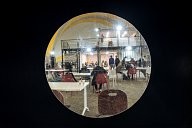
Mostly Sudanese, Afghan, Eritrean or Somali, the migrants accommodated in the centre of La Chapelle find there an alternative to the wild camps of Stalingrad.
Jan Schmidt-Whitley/Le Pictorium
LePictorium_0177155.jpg
Once in the "bubble", each person waits for an individual interview with Emmaüs employees to determine the course of action to follow according to their administrative situation. The majority of migrants are from Sudan, Afghanistan, Eritrea and Somalia
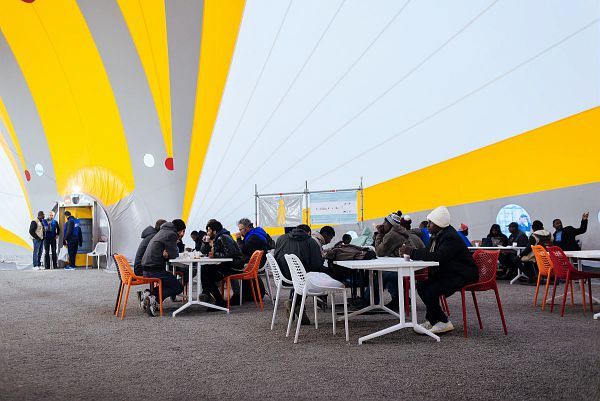
Mostly Sudanese, Afghan, Eritrean or Somali, the migrants accommodated in the centre of La Chapelle find there an alternative to the wild camps of Stalingrad.
Jan Schmidt-Whitley/Le Pictorium
LePictorium_0177156.jpg
Once in the "bubble", each person waits for an individual interview with Emmaüs employees to determine the course of action to follow according to their administrative situation. The majority of migrants are from Sudan, Afghanistan, Eritrea and Somalia
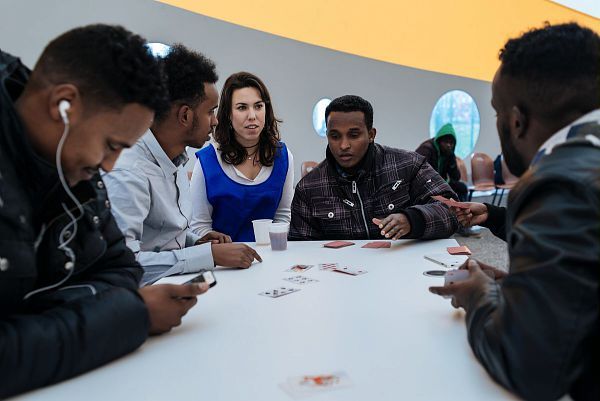
Mostly Sudanese, Afghan, Eritrean or Somali, the migrants accommodated in the centre of La Chapelle find there an alternative to the wild camps of Stalingrad.
Jan Schmidt-Whitley/Le Pictorium
LePictorium_0177157.jpg
In the "bubble", Emmaüs volunteers who are recognizable by their blue chasuble spend time with migrants. Cards games and French courses are improvised to entertain each other’s before one passes his individual interview in the presence of a translator if necessary.
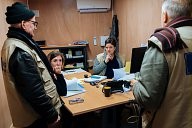
Mostly Sudanese, Afghan, Eritrean or Somali, the migrants accommodated in the centre of La Chapelle find there an alternative to the wild camps of Stalingrad.
Jan Schmidt-Whitley/Le Pictorium
LePictorium_0177158.jpg
Emmaüs teams meet regularly to discuss the day’s priorities in the "bubble". On the left, a translator speaking Dari coordinates with the person in charge of the bubble, sitting at her desk
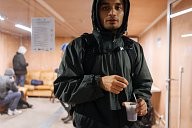
Mostly Sudanese, Afghan, Eritrean or Somali, the migrants accommodated in the centre of La Chapelle find there an alternative to the wild camps of Stalingrad.
Jan Schmidt-Whitley/Le Pictorium
LePictorium_0177159.jpg
Enayatullah Nadiri, a young Afghan of 19 years rests after spending the night outside waiting for the doors open. Co ee and snacks are available before people leave the "bubble" and enter in the center
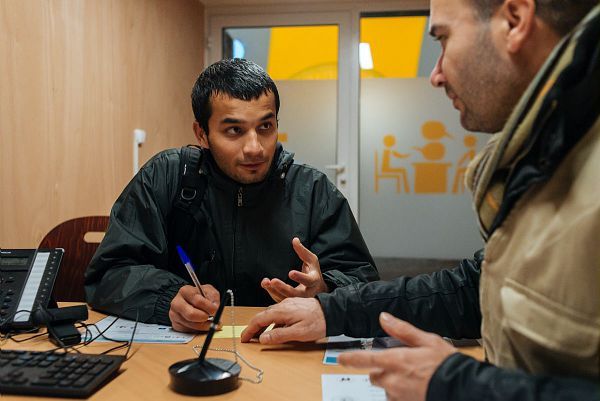
Mostly Sudanese, Afghan, Eritrean or Somali, the migrants accommodated in the centre of La Chapelle find there an alternative to the wild camps of Stalingrad.
Jan Schmidt-Whitley/Le Pictorium
LePictorium_0177160.jpg
Enayatullah Nadiri, a young Afghan of 19 years spends his individual interview with the teams of Emmaus. He answers various questions with the help of a translator. This interview then serves as a basis for the Emmaüs teams to determine the future course of each person entering the center of the Chapelle.
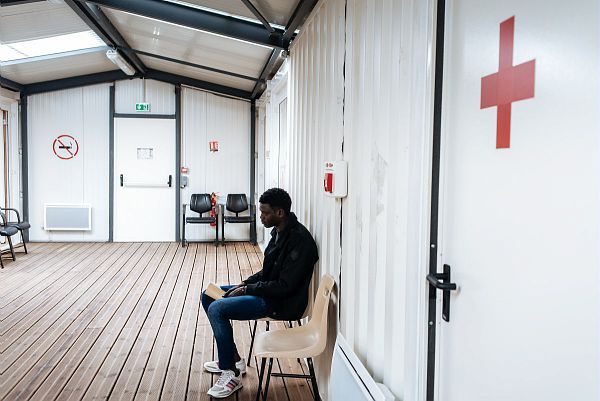
Mostly Sudanese, Afghan, Eritrean or Somali, the migrants accommodated in the centre of La Chapelle find there an alternative to the wild camps of Stalingrad.
Jan Schmidt-Whitley/Le Pictorium
LePictorium_0177161.jpg
A patient is waiting to meet MDM (Médecins du Monde, a French medical NGO) psychologists who work several days a week and order the opportunity for those who wish to consult a specialist. Many people who are housed su er from psychological problems, which are often translated into insomnia.
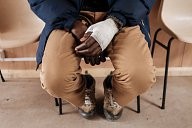
Mostly Sudanese, Afghan, Eritrean or Somali, the migrants accommodated in the centre of La Chapelle find there an alternative to the wild camps of Stalingrad.
Jan Schmidt-Whitley/Le Pictorium
LePictorium_0177162.jpg
A patient is in the waiting room of the dispensary to meet a SAMU Social doctor that is present all day and consults with appointments, except medical emergency. Each person who is accommodated begins his stay in the center with a medical examination and can then return whenever they wish during their stay.

Mostly Sudanese, Afghan, Eritrean or Somali, the migrants accommodated in the centre of La Chapelle find there an alternative to the wild camps of Stalingrad.
Jan Schmidt-Whitley/Le Pictorium
LePictorium_0177163.jpg
A Sudanese refugee who was tear-gassed by the French police earlier in the day while waiting in line to enter to the center of La Chapelle consulted a SAMU Social nurse.
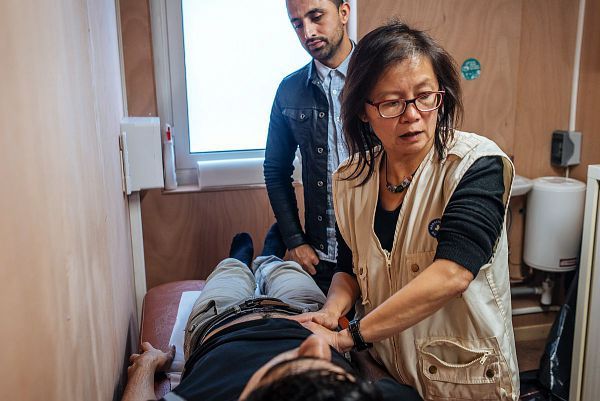
Mostly Sudanese, Afghan, Eritrean or Somali, the migrants accommodated in the centre of La Chapelle find there an alternative to the wild camps of Stalingrad.
Jan Schmidt-Whitley/Le Pictorium
LePictorium_0177164.jpg
An Afghan young man assisted by an interpreter consults a doctor of Médecins du Monde (MDM), a French medical NGO. He su ers from abdominal pain, which is doubtless without severity, as the symptoms have been present for several months. He had not had the opportunity to see a doctor since leaving Afghanistan earlier in the year.

Mostly Sudanese, Afghan, Eritrean or Somali, the migrants accommodated in the centre of La Chapelle find there an alternative to the wild camps of Stalingrad.
Jan Schmidt-Whitley/Le Pictorium
LePictorium_0177165.jpg
Once the stage of the "bubble" is over, each person is shown an explanatory booklet in his native language (Arabic, Somali, Dari, Pashtun, etc.). This booklet gives all the necessary information to the migrants who will stay a dozen days in the center.
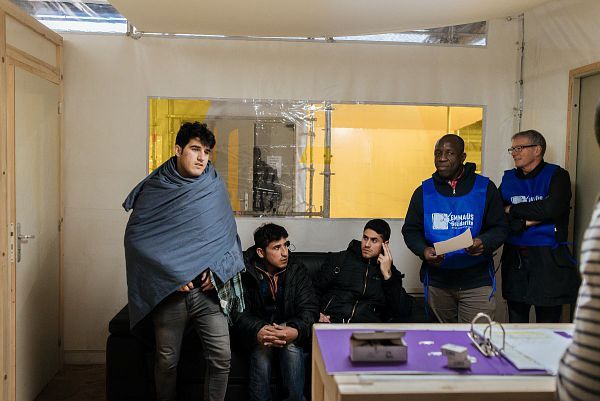
Mostly Sudanese, Afghan, Eritrean or Somali, the migrants accommodated in the centre of La Chapelle find there an alternative to the wild camps of Stalingrad.
Jan Schmidt-Whitley/Le Pictorium
LePictorium_0177166.jpg
After an interview in the "bubble", people enter the "hall" where they are allocated a bed. The employees and employees of Emmaus also explain the rules governing the life of the center and give them all the details and assistance they need to install them.
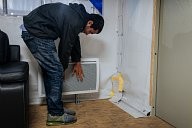
Mostly Sudanese, Afghan, Eritrean or Somali, the migrants accommodated in the centre of La Chapelle find there an alternative to the wild camps of Stalingrad.
Jan Schmidt-Whitley/Le Pictorium
LePictorium_0177167.jpg
Enayatullah Nadiri, after entering in the "hall", this 19-year-old Afghan boy is heating-up while waiting for the logistics of his accommodation to be in place. He spent the night in front of the center and su ered a lot from the cold.
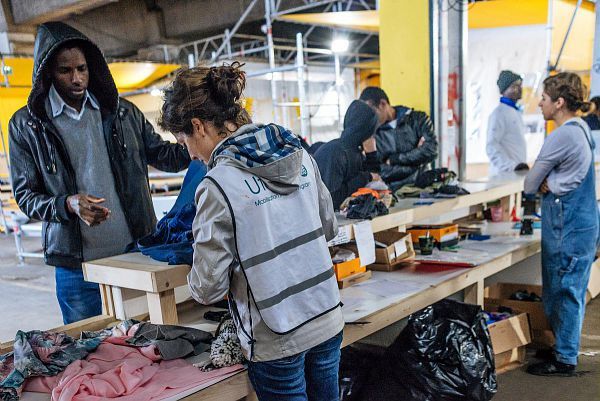
Mostly Sudanese, Afghan, Eritrean or Somali, the migrants accommodated in the centre of La Chapelle find there an alternative to the wild camps of Stalingrad.
Jan Schmidt-Whitley/Le Pictorium
LePictorium_0177168.jpg
Each person accommodated receives a passport which, besides regulating the meals and being used for identi cation at the doors of the center, also serves to note that the two sets of clothing that are o ered to each have been issued. The association Utopia 56 is in charge of all the logistics relating to clothing.
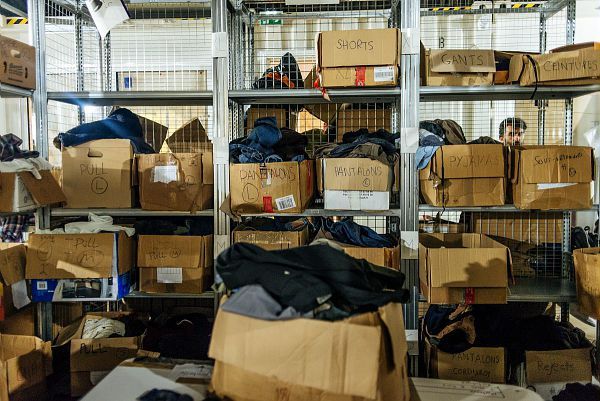
Mostly Sudanese, Afghan, Eritrean or Somali, the migrants accommodated in the centre of La Chapelle find there an alternative to the wild camps of Stalingrad.
Jan Schmidt-Whitley/Le Pictorium
LePictorium_0177169.jpg
Each person accommodated receives two sets of clothing. The association Utopia 56 is responsible for all the logistics relating to clothing.
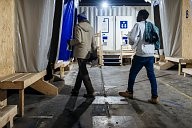
Mostly Sudanese, Afghan, Eritrean or Somali, the migrants accommodated in the centre of La Chapelle find there an alternative to the wild camps of Stalingrad.
Jan Schmidt-Whitley/Le Pictorium
LePictorium_0177170.jpg
Once the persons authorized to enter the "hall" each one is allocated a bed in a room which has 4. The center is divided into 4 "villages" of 40 people, each “village” has a sanitary, a shower and a refectory bloc. Here, an employee of Emmaüs accompanies a new entrant.
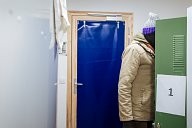
Mostly Sudanese, Afghan, Eritrean or Somali, the migrants accommodated in the centre of La Chapelle find there an alternative to the wild camps of Stalingrad.
Jan Schmidt-Whitley/Le Pictorium
LePictorium_0177171.jpg
Each newcomer is allocated a bed, padlock and a wardrobe to store his personal belongings in a 4 bed room.
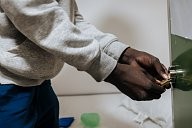
Mostly Sudanese, Afghan, Eritrean or Somali, the migrants accommodated in the centre of La Chapelle find there an alternative to the wild camps of Stalingrad.
Jan Schmidt-Whitley/Le Pictorium
LePictorium_0177172.jpg
Each newcomer is allocated a bed, padlock and a wardrobe to store his personal belongings in a 4 bed room.
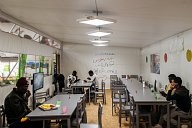
Mostly Sudanese, Afghan, Eritrean or Somali, the migrants accommodated in the centre of La Chapelle find there an alternative to the wild camps of Stalingrad.
Jan Schmidt-Whitley/Le Pictorium
LePictorium_0177173.jpg
Each "village" (the center has 8) has a refectory with a television, meals are served 3 times a day and everyone is free to go in during the day outside meal times.
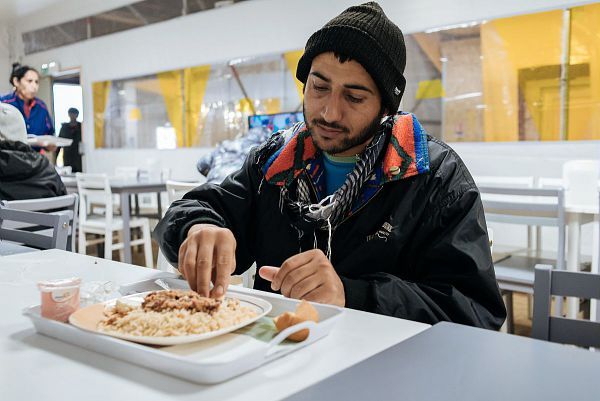
Mostly Sudanese, Afghan, Eritrean or Somali, the migrants accommodated in the centre of La Chapelle find there an alternative to the wild camps of Stalingrad.
Jan Schmidt-Whitley/Le Pictorium
LePictorium_0177174.jpg
A. is a 33 year old refugee of Afghan descent. For 9 days he is been present in the center, the maximum duration is 10 days normally. He comes from the town of Logar and owned a small grocery store. Insecurity forced him to leave his country. He is the father of seven children, all of whom remained in Afghanistan.
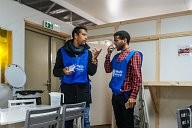
Mostly Sudanese, Afghan, Eritrean or Somali, the migrants accommodated in the centre of La Chapelle find there an alternative to the wild camps of Stalingrad.
Jan Schmidt-Whitley/Le Pictorium
LePictorium_0177175.jpg
Two volunteers from Emmaüs meet in one of the refectories.They speak rare languages and are translators waiting to nd a job.
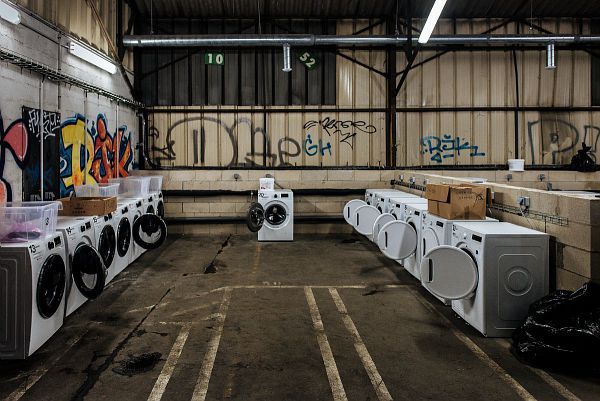
Mostly Sudanese, Afghan, Eritrean or Somali, the migrants accommodated in the centre of La Chapelle find there an alternative to the wild camps of Stalingrad.
Jan Schmidt-Whitley/Le Pictorium
LePictorium_0177176.jpg
A laundry area allows the housed persons to wash their clothes. They are deposited in the morning and can be recovered clean and dry in the afternoon.
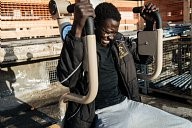
Mostly Sudanese, Afghan, Eritrean or Somali, the migrants accommodated in the centre of La Chapelle find there an alternative to the wild camps of Stalingrad.
Jan Schmidt-Whitley/Le Pictorium
LePictorium_0177177.jpg
Many rigs have been installed outside to allow those who wish to do sport and a little exercise. A young Sudanese refugee, native of Darfur, tries under a winter sun.

Mostly Sudanese, Afghan, Eritrean or Somali, the migrants accommodated in the centre of La Chapelle find there an alternative to the wild camps of Stalingrad.
Jan Schmidt-Whitley/Le Pictorium
LePictorium_0177178.jpg
On the initiative of activists of Utopia 56 and of volunteers, skateboards are proposed to the people who wish it. Courses are thus improvised in the area reserved for the sport and where are present many equipment. A young Libyan is trying the sport king of the western urban youth.
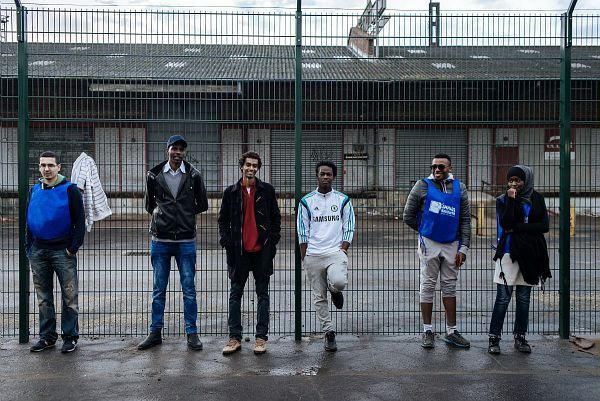
Mostly Sudanese, Afghan, Eritrean or Somali, the migrants accommodated in the centre of La Chapelle find there an alternative to the wild camps of Stalingrad.
Jan Schmidt-Whitley/Le Pictorium
LePictorium_0177179.jpg
Emmaüs volunteers in the company of refugees watch an improvided football match between volunteers and residents of the center.
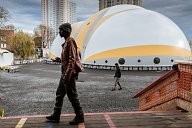
Mostly Sudanese, Afghan, Eritrean or Somali, the migrants accommodated in the centre of La Chapelle find there an alternative to the wild camps of Stalingrad.
Jan Schmidt-Whitley/Le Pictorium
LePictorium_0177180.jpg
A refugee in the center of La Chapelle run by Emmaüs passes tin front of the "bubble" thought by French architect Julien Beller.
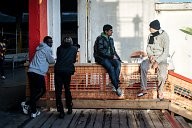
Mostly Sudanese, Afghan, Eritrean or Somali, the migrants accommodated in the centre of La Chapelle find there an alternative to the wild camps of Stalingrad.
Jan Schmidt-Whitley/Le Pictorium
LePictorium_0177181.jpg
During the day, the people staying in the center do not have many occupations. Many meet with each other to discuss. Residents may leave the center but few do so out of fear of the authorities and also of getting lost. Lack of money and local friends explain also the wish to stay in the center.
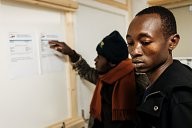
Mostly Sudanese, Afghan, Eritrean or Somali, the migrants accommodated in the centre of La Chapelle find there an alternative to the wild camps of Stalingrad.
Jan Schmidt-Whitley/Le Pictorium
LePictorium_0177182.jpg
Every evening in each "village", a list of the departure of the next day is posted. Everyone then discovers whether to prepare to leave or not. In general, 2 departures per day are organized, one in the morning and one in the afternoon. Each person concerned meets members of OFII (French Migration and Integration O ce) and Emmaus for more details.
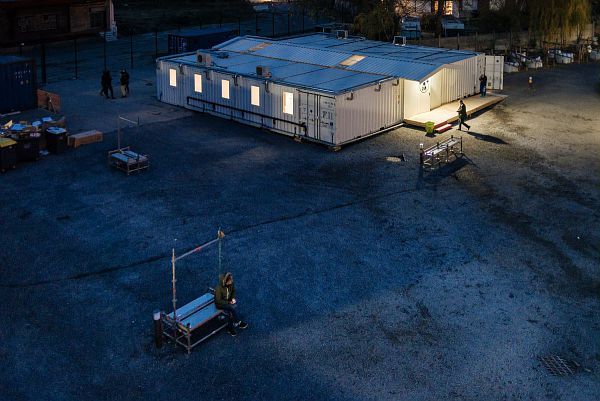
Mostly Sudanese, Afghan, Eritrean or Somali, the migrants accommodated in the centre of La Chapelle find there an alternative to the wild camps of Stalingrad.
Jan Schmidt-Whitley/Le Pictorium
LePictorium_0177183.jpg
A migrant gets lost on his mobile phone. A wi network is o ered free of charge on the site of the center. In the background, the health center where teams of doctors, nurses and psychologists are available every day.
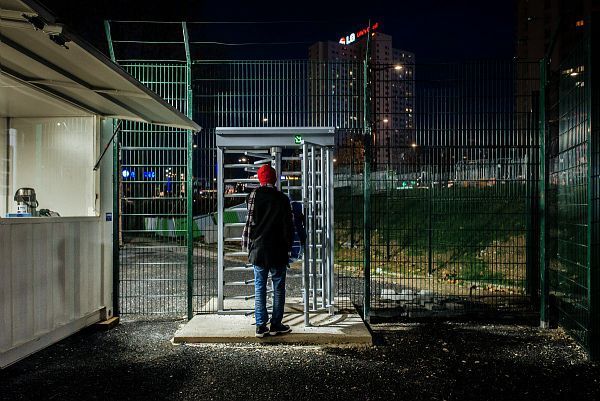
Mostly Sudanese, Afghan, Eritrean or Somali, the migrants accommodated in the centre of La Chapelle find there an alternative to the wild camps of Stalingrad.
Jan Schmidt-Whitley/Le Pictorium
LePictorium_0177184.jpg
Every person housed can enter or leave as he wishes from the center during opening hours, he must present his passport from Emmaus handed over upon arrival. Turnstiles are installed at the entrance to regulate the people coming in and out.
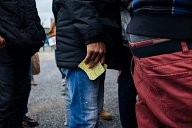
Mostly Sudanese, Afghan, Eritrean or Somali, the migrants accommodated in the centre of La Chapelle find there an alternative to the wild camps of Stalingrad.
Jan Schmidt-Whitley/Le Pictorium
LePictorium_0177185.jpg
Once his name is on the list, every hosted person must show up at the departure of the buses, with his luggage and identi cation passport in the center.
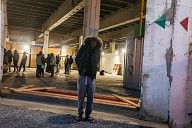
Mostly Sudanese, Afghan, Eritrean or Somali, the migrants accommodated in the centre of La Chapelle find there an alternative to the wild camps of Stalingrad.
Jan Schmidt-Whitley/Le Pictorium
LePictorium_0177186.jpg
A young Sudanese is waiting for the time of departure. In general 2 buses leave per day, people do not know their exact destination, only the general area. All this information is given to them when they board the bus.
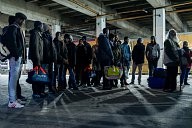
Mostly Sudanese, Afghan, Eritrean or Somali, the migrants accommodated in the centre of La Chapelle find there an alternative to the wild camps of Stalingrad.
Jan Schmidt-Whitley/Le Pictorium
LePictorium_0177187.jpg
The persons whose names are on the departure list shall arrive at the time indicated at the place of rendez-vous. An Emmaüs social, Gérard, explains the details and ensures that everyone is present.
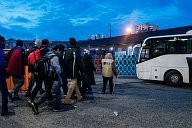
Mostly Sudanese, Afghan, Eritrean or Somali, the migrants accommodated in the centre of La Chapelle find there an alternative to the wild camps of Stalingrad.
Jan Schmidt-Whitley/Le Pictorium
LePictorium_0177188.jpg
The persons whose names are on the departure list shall arrive at the time indicated at the place of rendez-vous. An Emmaüs o cial, Gérard, explains the details and ensures that everyone is present. The migrants then get on the bus.
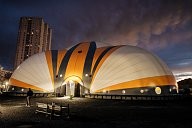
Mostly Sudanese, Afghan, Eritrean or Somali, the migrants accommodated in the centre of La Chapelle find there an alternative to the wild camps of Stalingrad.
Jan Schmidt-Whitley/Le Pictorium
LePictorium_0177189.jpg
An overview of the "bubble" or Pôle d'Acceuil. It is the architect Julien Beller who was responsible for his development, no structure is necessary for his erection, only the air that is constantly blown inside by a breathing system allows him to be maintained.

 Humanitarian center of La Chapelle for migrants in Paris / JSW
Humanitarian center of La Chapelle for migrants in Paris / JSW